There are a large number of recreational activities in the World of Avatar, created for both simple enjoyment and fierce competition. These range from physically demanding sports such as the Air Nomads' airball or the Southern Water Tribe's ice dodging[6] to games like Pai Sho[5] that challenge the mind.
Many games of a particular nation incorporate that nation's native bending element. For example, airbending is utilized for airball,[1] and earthbending for earth soccer.[3]
Air Nomads
Airball
- Main article: Airball
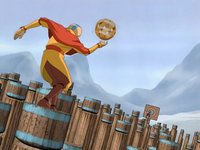
The airball court consists of a number of large vertical poles.
Played on a field of evenly spaced vertical poles, airball was a popular sport with the objective of scoring points by shooting a ball into a goal. The aforementioned goal is a circle that spins when hit. Players can score a point by either leaping from pole to pole until they are able to simply toss the ball in or by airbending the ball and causing it to ricochet and eventually enter the goal. As the game is greatly dependent on airbending abilities, players who lack airbending are at a great disadvantage.[1]
Bison polo
Bison polo was a popular game played by the Air Nomads. The main objective of the game was to force a ball into an opponent's goal while flying on a sky bison.[7] Championships for the game were held at the Northern Air Temple.[8]
Kite flying
The Air Nomads fashioned kites in the likeness of cranefish for use after the celebration of Yangchen's Festival. These kites did not require strings, since they were controlled using airbending.[9]
Water Tribes
Ice dodging
- Main article: Ice dodging
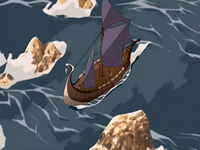
Ice dodging has long been a rite of passage for young men.
Ice dodging is a rite of passage for young men in the Southern Water Tribe. When a young boy reaches the age of fourteen, his father takes him along with two others in the tribe, and lets the boy captain the boat through a series of icebergs that are difficult to maneuver through. If the boy manages to steer through, he and the two others will be awarded a mark from the boy's father. The mark with a crescent moon is the Mark of the Brave, the mark with a curved line and a dot underneath is the Mark of the Wise, and the Mark of the Trusted is a curved mark.[6]
Ice marbles
Ice marbles is a game played by the citizens of the Northern Water Tribe. The game is never shown being played, but it is noted that Sangok wished he could play ice marbles instead of attending his waterbending training.[10]
Penguin sledding
- Main article: Penguin sledding
Penguin sledding is a children's pastime in which one mounts the back of an otter penguin,[2] and sleds down hills of snow and through natural channels carved through glaciers. It is thoroughly enjoyed by both the rider and the "sled".
Water gun booth
The water gun booth is an attraction that was featured in the Southern Water Tribe during the Glacier Spirits Festival. It is played in groups of six people, and the objective is to accurately squirt water through an opening; squirting enough water through said opening will cause a bell to ring, and the player will win a prize.[11]
Earth Kingdom
Earth Rumble
- Main article: Earth Rumble VI
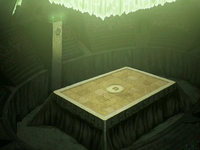
Earth Rumble VI is a popular Earth Kingdom attraction.
This underground earthbending tournament is held in a giant earthen arena in Gaoling. The Earth Rumble competitions feature flamboyant fighters with theatrical stage names, each trying to verbally intimidate their opponent before knocking the other out of the ring with earthbending. The competition is a popular Earth Kingdom attraction; the stands at Earth Rumble VI are typically full except for the front rows, which are in danger of being pummeled by flying rocks and losing competitors.[12]
Earth soccer
- Main article: Earth soccer
Earth soccer is a game played just like soccer, but with earthbending to guide and move the ball. Earth soccer, being a somewhat gritty sport, is commonly played by the lower-class citizens in the Lower Ring of Ba Sing Se.[3]
Elephant koi riding
The elephant koi is a fish that resides in the Kyoshi Island bay. These gigantic koi are very friendly and do not mind taking on a passenger. Being able to hold one's breath is a must, as is keeping an eye out for the unagi, a monstrous-sized eel; if the koi gets eaten by the unagi, the rider goes down with it. Aang rode an elephant koi at least twice in his life.[13]
Gliding
- Main article: Glider
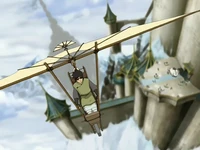
Teo had a glider built for him by his father to allow him a new life in the air.
At the Northern Air Temple, the mechanist designed and built gliders based on the ones used by the Air Nomads. His gliders did not require airbending to fly, instead using a system of pipes that delivered hot air updrafts around the temple. One pilot would demonstrate a series of fancy or difficult maneuvers, and challenge another pilot to match them.
The wingspans of the mechanist's gliders were longer than those the Air Nomads used, and were rectangular to maximize lift. On the back of the glider under the tail wing is a leg 'hammock' for the pilot's feet. Teo's unique glider was connected to the footrest and the top of his wheelchair, and used two levers for steering.[8]
Omashu mail system slide
The mail delivery system in the Earth Kingdom city of Omashu contains miles of tubes and chutes. Though not an official city sport, Bumi invented this game when he was a child, as he perceived that the mail system could be used as a huge slide.[14]
Power disc
- Main article: Power disc
Power disc is a game that involves the manipulation of a metal disc within a large rectangular arena utilizing solely metalbending; the objective is to ultimately land the disk in one of the two nets on either end of the playing field. A player attempts to score a goal by using metalbending to ricochet the disc against the walls of the arena or any of the four pillars situated in the center of the field in the hopes of preventing his or her opponent from blocking the shot. When a goal is scored, a buzzer sounds, signaling the scorer's victory. The game was invented in the city of Zaofu by the twin sons of the city's leader Suyin Beifong, Wei and Wing.[15]
Redemption
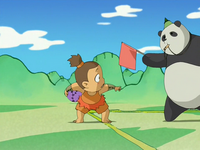
Redemption was a game made up by Aang in attempt the end the feud between the Gan Jin and Zhang tribes.
A reconstructed version of the Gan Jin tribe's Redemption ritual, Aang described this game to persuade the Gan Jin and Zhang tribes to end their one hundred year feud. The story explains the events that transpired between the tribes' founding patriarchs, Jin Wei and Wei Jin. The sacred crystal orb was just a regular ball, and the Eastern and Western gates were goal posts. Jin Wei was running with the ball when he fumbled it. Wei Jin picked it up and began heading toward a goal post, but he stepped out of bounds. By rule, he was put in a penalty box for two minutes, not twenty years, as the Gan Jin had believed. Game-wise, this is a typical "run the ball to the goal" game, but with panda referees, and when a player scores a goal, everyone yells, "Redemption!"[16]
Fire Nation
Gambling
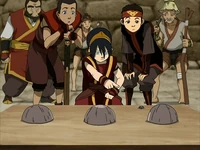
Toph used her seismic sense to cheat while gambling in the Fire Nation.
There are several popular types of gambling seen in the Fire Nation, including the shell game, where the dealer places a rock under one of three cups and shuffles them around, challenging the player to guess which cup contains the rock. Toph was able to fix the game by using her seismic sense to see where the rock was and prevent the dealer from fixing the game himself.
The "dice" game is similar to craps. Toph was able to use earthbending to ensure the dice landed in the combination on which she had bet.
Another game consists of a player using a hammer to hit a base that throws a puck upward along a track. At the top is a bell. The game is won when the player strikes the base hard enough to ring the bell with the puck.[17]
Hide and explode
- Main article: Hide and explode
Hide and explode is a children's game similar to hide and seek, but with a twist. After playing a game of hide and explode, Aang's clothes were covered in burns, meaning that it more than likely involves fire, but not necessarily firebending since Aang had not yet learned it.[18]
Kuai ball
- Main article: Kuai ball
Kuai ball is a sport similar to volleyball, but played with both hands and feet, and it is played in a round field. It is usually played on the beach and is popular among vacationers on Ember Island. A background in martial arts is beneficial in order to be competent against opponents.[4]
Street Bender
Street Bender is a fighting game featured in the Ember Island Arcade. Two players face each other using warrior dolls to simulate combat. A game costs one silver piece, and the players use two metal rods to maneuver their dolls. Pressing the button on the rods causes the dolls to attack, and firebending into the metal rods gives the player a super attack. Each hit costs the player one of his or her three life bars, and the player who loses all of his or her life bars loses the game.[19]
United Republic of Nations
Pro-bending
- Main article: Pro-bending
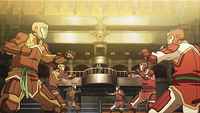
Pro-bending is popular throughout the world.
Pro-bending is an extremely popular sport in Republic City, spread throughout radio broadcast to the rest of the world. Gameplay involves two teams of three benders, and the objective of the sport is to gain as much territory within the ring as possible within a set amount of time during each round, or, alternatively, to push the opposing team over the edge of the ring. A tournament is held every year with the winner earning a cash jackpot.
Movers
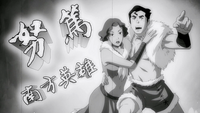
The films from The Adventures of Nuktuk: Hero of the South were the first movers developed for public screening.
The movers or cinema is the most modern recreational activity in the World of Avatar, coming to be in 171 AG, when The Adventures of Nuktuk: Hero of the South were released in Republic City. The new past time activity instantly gained massive approval, mostly from children, who comprise the largest demographic, but also from adults who were amazed by both the new technology and by the storyline. Although the movers were distributed outside the borders of Republic City, they were met with doubt, while they gained massive approval in the city itself.
Four nations
Card game
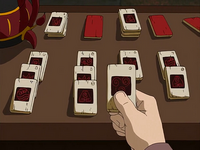
Card games are played across all four nations.
This game seems similar to solitaire. The cards are the size of hanafuda cards. On each of the card faces is one of the elemental bending symbols: airbending, waterbending, firebending, or earthbending, and in the upper right corner is a different element symbol. The game was played by Iroh,[2] and by Katara and Sokka;[20] it can be played by one or two people. The setup of the cards is similar to the forty-card kabufuda deck, which has four suits of ten cards each, numbered one through ten.
King of the Hill
King of the Hill involves any number of players in their attempt to "dethrone" the reigning king or queen, who is located on a pre-designated plot of land called the "throne" or "hill". Those who oppose the monarch may, depending on the rules decided by the players, use whatever skills they have to take the throne, but the game is not meant to be dangerous. Weapons, such as a bender's respective element or another item, may be employed in the effort. To win the game, at least one player must find a way to remove the monarch from his or her throne and claim it by taking the place atop the "hill" or other pre-chosen destination. The reigning king or queen may retaliate, however, if he or she feels it is necessary to defend his or her royalty, but leaving the throne forfeits the monarch's title and leaves the throne up for grabs. While choosing that the destination of the throne is a different place from the predetermined location mid-game is considered cheating, the king or queen literally moving the hill, or the throne's location, by means of using a skill is not.[21]
Pai Sho
- Main article: Pai Sho
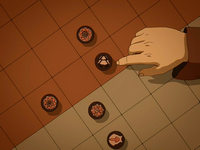
Pai Sho is enjoyed by people of all ages and nations.
Pai Sho is a two-player game that is popular throughout the World of Avatar, appealing to people of all ages. Dating back to the era of Raava, legend has that it was invented by the spirits, and the game has remained popular among people all over the world since that time. It bares a resemblance to both Chinese chess and checkers. A popular pastime enjoyed by people around the world, Pai Sho is also used by the secretive Order of the White Lotus in order to identify its members by constructing a lotus pattern on the board, as shown by Iroh.[22] The most famous Pai Sho tile is the white lotus.[5]
"Water, earth, fire, air"-game
The name of this game is never given, but it bears a great resemblance to rock, paper, scissors, except that it uses the four elements. As shown by Aang and Sokka's game, earth beats fire.
If earth beats fire, it can be presumed that it uses the Avatar Cycle, which follows the order: water, earth, fire, and air. Water would beat earth, earth beats fire, as shown by Aang and Sokka, fire beats air, and air beats water. It is very likely that each hand symbol is made by one of the typical moves of the bending arts like the clenched fist, which is a frequent earthbending movement. The hand position for fire, however, seems to represent the element itself.
During one of Aang's flashbacks, two Air Nomads are seen playing this game and in a tie, both hold out their hands perpendicular to the ground.[23] This seems to be air, since they are airbenders and would favor this element, and because this is a common airbending tornado technique.
Yoga
Yoga is a type of exercise and a natural therapy used for meditation, relaxation, and medical benefits like stress reduction; it has many types of positions and respiration techniques. Yoga can be practiced next to steams; Katara and Aang practiced yoga inside of a steaming cave when Aang was stressed and restless because of the upcoming invasion of the Fire Nation.[24]